Guest post – author: Nikola Prica
1. Foreword – Bike Gremlin
Nikola Prica shared a story that, at least to me, was beautiful and I agreed it should be shared. While just enjoying reading it, someone might get similarly inspired to breathe a new life to an old bicycle – an endeavor that lets one learn a lot of interesting things about mechanics, bicycle maintenance, and about themselves.
In brackets, occassionally, I put links to articles explaining the technical parts in more detail (for those eager to go on a similar adventure), but I recommend before clicking any of those links that you read the story, in one breath, as I have read it. 🙂
I explained some of the technical challenges of giving new life to an old frame – and how to overcome them – in the article:
Vintage bicycle frames with modern parts
2. The story about 40 years of Rog Senior bicycle… and life
This story starts over 40 years ago, when I had, at least in part, fulfilled my childhood dreams and bought a first “real” bicycle with speeds. “In part”, because I bought a five-speeder, that was available, not a ten-speeder, that was on a waiting order list, or required a travel of over hundred kilometer to the nearest store that had it in stock. Before, in elementary school, I made 30 kilometer tours on macadam roads over the Vrpile (820 metres of elevation, raound 170 m above korenica), or shorter tours to Vratnik, on a mixture of macadam and asphalt paved roads (around 780 m elevation). Of course, my first impression with the new bike was “awesome”, but I also faced a first problem straight away. The frame was small – only 54 cm, seatpost was too short for my 187 cm of height, and my riding position was too low for longer rides. The solution was a Pony (cult city commuting bicycle made by the same manufacturer – “Rog”), its seatpost that is, which enabled me a comfortable riding position and maximum power on the pedals, which led to successful cruising around Korenica area and scaling local hills, which led me to feeling happy with the five-speeder as a bicycle touring vehicle. That was my first adaptation of the new bicycle, that will become one of the many adaptations and repairs, but it also gave it a long life, that was prolonged by a forced 12 year break in a Zagreb basement.
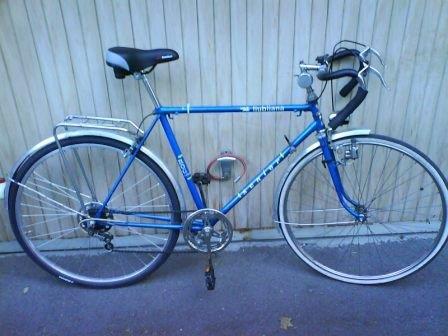
First test came after two years, when, at under 20 years of age, I went on an adventure of travelling to the sea with my Rog Senior. It was the year 1982, I was at full strength, never lacked strong will, and the feeling was magnificent. Preparations were relatively short, I made 300 kilometres in preparation rides, with the longest ride being to Udbina (around 65 kilometres), and I felt completely ready for the endeavour. My partner was a guy from Maribor (colleague from the studies in Zagreb) and the agreement was for him to come via a train to Karlovac, then get on the road (Lika highway) to Korenica, while I come to Slunj and wait for him.
Arranged and done, we met at Nikšić Slunjski, and arrived to Kornica that afternoon. Spent the night there and went on our adventure, without much experience for such undertaking. We climbed Gorica (721 m elevation), Udbina (809 m) and Prezid (746 m) on Velebit mountain, to descend down to the sea level in the village of Maslenici, below a bridge bearing the same name. Around 100 kilometres with many ascends and descends were done in around five and a half hours, full of strength and determination. On the next day we set off towards Biograd, then toured around Zablaća near Šibenik, and Šibenik, returning back to spend some time at Murter. We didn’t have appropriate gear – tent to name one (we improvised that with two tent wings, tied with a string, open on the sides). We had sleeping bags and a will to travel.
After twelve days, my companion gives up on returning the same way and takes a train from Zadar back to Maribor. Smart, or… Anyway, I completed the 130 kilometres of the return journey in twelve hours, with a very exhausting climb up the Velebit mountain – 20 kilometres of climbing at about 740 m of elevation to the Prezid tunnel, with scorching sun above and heated rocks and asphalt below. Up to this day I haven’t repeated, nor attempted a similar stunt. After that, I concentrated on local tours to Bunić, Trnavac, Plitvice, Homoljac and Frkašić, climbing Vrpile pass (821 m elevation), Pogledalo (884), Vratnik (780) and Trnavačka Korita (810 m), all from a starting base at about 650 m elevation.
The frequent need for climbing, that was rewarded by adrenaline on the fast descends (fast bicycle cornering technique), led to the first rework on the Rog Senior. In Metalija Commerce, in the city of Zagreb (the only bicycle and moped shop at the time) I bought a Rino front derailleur and 52/42 cranks with a cotter attachment (only left crank was secured with a cotter, the right one was welded onto the axle, which turned out to be more reliable than having both cranks attached with a cotter), which turned Senior into a ten-speeder, and made all the climbs a lot easier.
This adjustment was the final one for a long period of my bicycle. From 1986 I had started working in Maribor, and from 1988 Senior was with me in Maribor, then going to Zagreb, where I went to work that same year. At the time I wasn’t riding very much, didn’t have anough time, while my late twenties weren’t helping with that. It all got spiced up with politics, so I left Zagreb in 1991 (civil war start), while circumstances resulted in my bicycle ending up at my friend’s basement in Knežija, where I had lived about 6 months before leaving Zagreb.
I faced difficult times. Until 1995 I lived in Korenica, and rode Unis five-speeder with a “women’s” frame, that, like everything else, was left behind after the “Storm” (all the storms). The following period was dedicated to sole survival, so there wasn’t much thinking about riding a bicycle, except on occassions. So, in May 2000, I came across a pile of bicycles near “Serbia” Hotel (those were the competitors of the “Tour through Serbia”) and of course I had thought about my almost forgotten Rog Senior in Zagreb. Things changed in 2003, when I moved to Sremčica (where I live today) and before that went with my acquintance Damir to Zagreb to bring Sernior to Korenica, after 12 years. It is the rare property of any value that I have left after the “Storm”.
In the Summer of 2004 I brought the bicycle home, in parts, disassembled it and completely restored it in my basement – to its original, archaic, configuration. It was still working fine, but over time I got more and more tired, and its climbing abilities were no longer matching my needs, while the place where I lived required a lot of climbing, for which the bicycle’s gearing wasn’t suited; and a lot of descents, for which the outdated brakes were not a good match, and it led me to some risky situations with poor braking. The lifetime of the bicycle was marked with a true revolution in the cycling industry, most notably the emmergence of “mountain” bicycles (first Rog mountain bikes cost 1000 German Marks at the time, with 18 speeds and friction shifters), and its “technics” was obsolete even at the time it was purchased, even though it did retain its functionality.
First reconstruction was inspired after reading the article: “From a grandmother to a maiden – a road bicycle for 100 euros” (the linked page is in Serbocroatian). The author, from the city of Niš, who described his adaptation, led me to first signifficant modification of my Rog Senior, that consisted of replacing the cranks with a triple 42/32/22, Rino derailleur with a Shimano front deraileur (front derailleurs explained), and swapping the drop bars for flat bars. I kept the wheels, brakes, rear sprockets and rear derailleur, but that also kept the downsides of the bicycle for the terrain where I ride. Poor braking, a lot easier climbing, and problems with Thompson bottom bracket didn’t provide much joy. Thompson bottom bracket was made with poor quality and quickly became loose, requiring frequent replacement and adjustment, which killed any enthusiasm.

On the following year I gave up on Senior, leaving it “in reserve”, and bought a mint condition trekking bicycle, on which I replaced cranks and cassette on the first year, switching from the original 48/38/28 to 42/34/24, and at the back from 28/24/22/20/18/16/14 to 34/24/22/20/18/16/14, which gave me a good climber for my age (other half of the fifth decade) and for climbs and descends of 150 metres on each ride, often more, with 15 % climbs that this drivetrain took without much effort.
Of course, these adaptations took investing in some special tools: frewheel removal tool, crank puller, and later I got a bottom bracket tool as well. Working on the trekking bike after three years, made me consider whether Rog Senior can be improved, with acceptable amount of investment, into a bicycle of the similar quality and characteristics.
I stripped all the parts from the Senior, and was amazed by the frame – it weighed under 3 kg (2.765 kg precisely), with no corrosion and defects, just some minor scratches from previous use. I didn’t think it needed painting, so left it in its original metallic silver, with all the original manufacturer’s stickers.
The biggest downside of the original frame was solved with the help of mechanic Rade, from Zrmanjska street in Belgrade, who gave me a solution for the bottom bracket. I installed a bottom bracket shell cut from an old bicycle of my son, and knocked it in without any welding, to avoid potential frame corrosion.
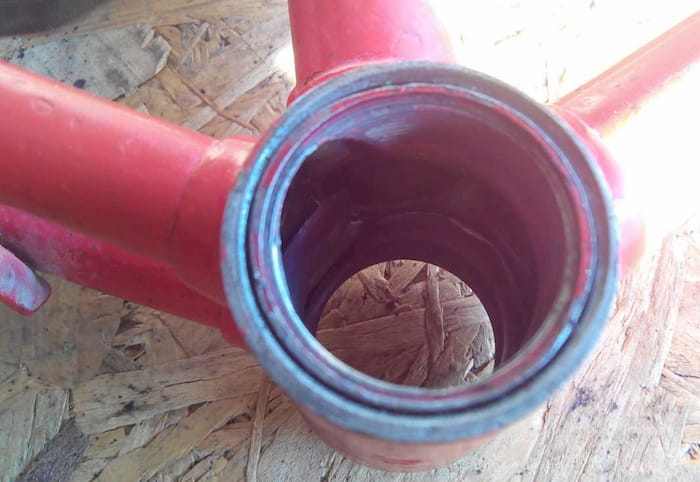
Picture from BikeGremlin’s collection, from another bicycle, just to demonstrate the patent
Cranks are Shimano (42/32/22) Tourney TX, with a Shimano Alivio 68 bottom bracket (square taper cranks), wheels are Capriolo 28″ Krypton X (622-19), with 622-37 tyres (bicycle tyre sizing standards), while cassette is a Shimano MTZ 31 7-speed freewheel (34/24/22/20/18/16/14), which allows for easy climbing at my age, even on steepest hills. Chain is KMC Z50 7-speed one.

All this led to a logical question – how to stop? Standard Senior brakes (“deep” ones) weren’t very good even when they were new, but now the age and technological development are both advanced. I decided to go with Logan V-brakes, and brake levers from the same manufacturer, which required further reconstruction (types of mechanical bicycle brakes). Brake housing was also important (I took teflon coated ones) for efficient braking in any situation (shifter and brake housing, and cable standards).
First solution was welding V-brake mounting pins, which would probably have cost a lot. So I decided to replace the front fork with one that has those pins (types of bicycle fork brake mounts), but that was easier said than found in Belgrade. Finaly, at a mechanic on Smederevac I found a matching fork and successfully installed it, solving the front brake problem.
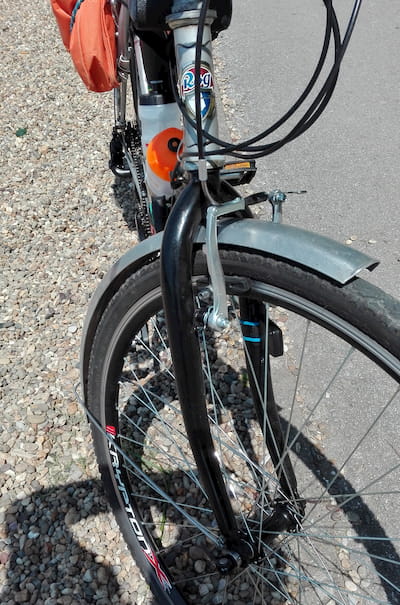
Rear end was a different story, because welding V-brake mounting pins wasn’t easily done on the thin tubing of the frame. I found an unconventional solution by cutting a part of my son’s old bicycle’s frame, along with the V-brake pins, and attached it using M6 screws and 4 clamps, without any welding. That solved the rear brake problem, and after one season the braking performance showed a lot better characteristics, than it had cost (in terms of pars and the labour).

Braking is very good in all the riding conditions, and even at speeds of around 60 km/h, one can safely stop, or control bicycle’s speed. Of course, every climb ends with a descent, sooner or later, and brakes are crucial then.
Derailleurs are Shimano. Front one was left from the previous adaptation, while the rear one is Tourney TY 500, with a maximum capacity of 34 to 11 teeth (capacity and other characteristics of rear derailleurs), which enables easy recreation cycling, with relaxed gear shifting. Controlls (shifters) are Shimano tx30, friction for the front derailleur, while the rear one is indexed (indexed and friction shifting explained).
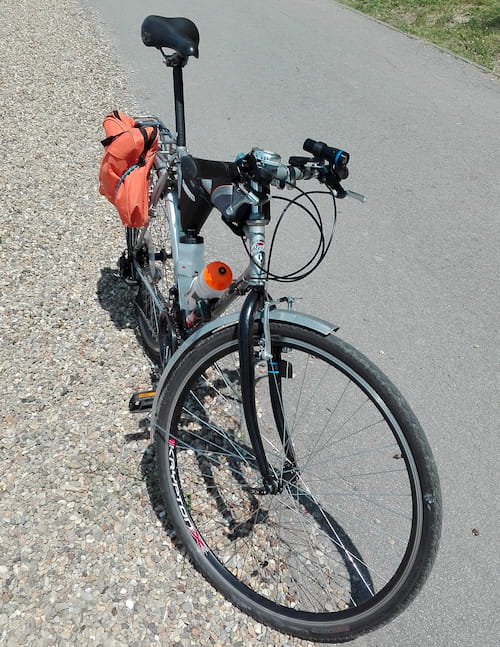
Finally – the effect of these adaptations of a 40-year old bicycle. Primarily, the frame is well preserved, I hope it will last for ten more years, if health serves me, even longer. You can estimate for yourself how much all the parts cost (I bought all the parts during the winter off-season, when parts are cheapest), labour doesn’t count, of course, but there is the joy of a work well done, as well as the usefulness of the upgraded bicycle. I had achieved my goal, to get a bicycle that suits my needs, while preserving all the retro elements and installing modern key drivetrain parts, which makes it ride well and the use justifies all the effort of an inexperienced amateur.
Of course, this required a lot of learning and correcting mistakes (it was, after all, a prototype), but now it is a capable bicycle with a retro-look (frame, mudguards, stem, kickstand, rear rack, seatpost – original elements left on the bicycle), which often leads to people asking “is that a new Rog?” If cost-effectiveness was judged, I don’t think it would all have been justified, but considering my emotions towards this old guy, then it was more than worth it. The usefulness of this bike can be seen in the following:
- Original five-speeder went 19.2 km/h in the slowest gear (at 80 pedal revolutions per minute), going 434 cm for one turn of the pedals.
- Redone into a ten-speeder, it went 17 km/h (80 rpm) and travelled 350 cm for one turn of the pedals.
- 3×15 gearing provided 8.8 km/h and a travel of 184 cm (but that an unrealiable bottom bracket design)
- Final version goes 6.93 km/h, travelling 141 cm.
This shows the gains of the newly installed drivetrain, but the real impression can only be felt when climbing 15+ % grades, allowing me to slowly take those climbs even at my age, and then safely descend.

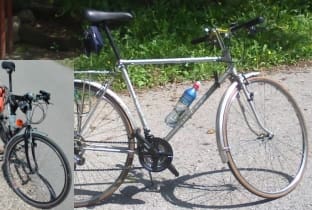
Que buena y inspiradora historia.
My primary bicycle is a 1979 Fuji 10 speed, selected for its relatively heavy frame and steel rims because of problems I’d seen with lighter materials. Its original square taper crank axle failed like the one you show, though I noticed it while I could still pedal carefully home.
Thank you for the ball bearing information; for years I’d bought repair materials from bicycle shops, but now none in my area have any interest in bicycles more than 20 years old. Luckily, my local hardware store had them in stock.